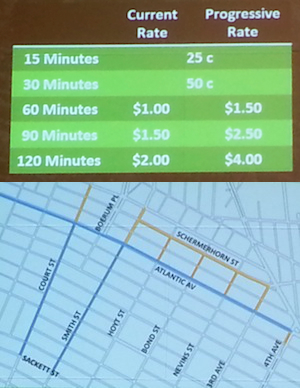On-street parking reform for Atlantic Avenue, Court Street, and Smith Street in Brooklyn moved ahead last night with a 6-0-1 vote from Community Board 2's transportation committee in favor of a new DOT PARK Smart zone. The proposal [PDF], prompted by a request from the owner of Sahadi's, aims to curb traffic and increase on-street parking availability for retail shoppers by allowing meter rates to rise after the first 30 minutes.

Presently, Atlantic Avenue west of Fourth Avenue and Court and Smith Streets between Atlantic Avenue and Sackett Street includes a mix of one- and two-hour limits, with rates at $1 per hour. Today, with limited enforcement of time limits, it's common for some motorists to park all day on busy commercial streets -- even as nearby garages sit mostly-empty -- while retail customers circle for available spots.
"People are staying all day on both sides of Atlantic," said DOT PARK Smart manager Manzell Blakeley. "People are really staying for four or five hours."
The PARK Smart proposal would discourage long-term parking with a pricing structure that ramps up charges for longer stays. The area would receive a uniform two-hour limit, and rates would remain at 50 cents for the first half-hour. But the second half-hour would cost $1, the third would also cost $1, and the fourth would cost $1.50. A driver looking to skirt the rules and keep paying the low rate for long stays would have to feed the meter every 30 minutes.
Charlie Sahadi, who owns Sahadi's food store on Atlantic Avenue, said that it can be difficult to know how customers get to the store, though he often hears complaints from customers who have to circle for parking. He mentioned the problem to State Senator Daniel Squadron, who connected him with DOT's PARK Smart staff.
"If you're in the retail business, you depend on customers coming in and buying stuff," Sahadi said. "My aim is to get more foot traffic on the street."
Sahadi thinks DOT's progressive rate structure will make it easier for his customers find parking, and is glad that it can be tweaked in the future. "One of the beauties of PARK Smart is, it's flexible," he said. "It's worth a shot."
To come up with the new policy, DOT interviewed over 100 business owners and held an open house to get feedback. The agency also used time-lapse photos of the area's streets -- a new data-collection method for PARK Smart -- to determine parking occupancy and duration rates.
According to merchants, who expressed support for longer time limits and progressive parking rates, six in ten of their customers walk from nearby areas, while 22 percent drive.
Because the survey relies on self-reported estimates from business owners, the percentage of customers who drive is probably even lower than the survey indicates. "A lot of people we interview are the owners, who tend to drive more than their customers or even their employees," DOT's Chris Hrones said. PARK Smart intercept surveys of customers in nearby Park Slope showed that only 15 percent of customers arrived by car, and surveys in other cities have confirmed that shop owners often over-estimate the importance of parking.
After approximately one year, DOT will evaluate the impact of PARK Smart on the area and check back with the community board about whether to maintain, modify, expand, or eliminate the program. Atlantic Avenue, Court Street, and Smith Street would join Jackson Heights, Park Slope, Greenwich Village, and a now-defunct initiative on the Upper East Side as part of DOT's PARK Smart program.
Tomorrow evening, DOT will present the plan to the transportation committee of Community Board 6, which includes sections of Court and Smith Streets affected by the PARK Smart proposal. CB 2's full board will also vote on the proposal on March 13.
Also last night, the MTA provided an update on expansion of bus service to the Brooklyn Navy Yard, part of last year's partial restoration of service cuts. The B67 will be extended north on Jay Street, across Vinegar Hill, and will enter the Navy Yard at the Sands Street gate. Like other visitors entering the Navy Yard, bus passengers would go through a security check once they get off the bus within the facility.
An initial proposal had the route running seven days a week and terminating within the industrial park, but the Brooklyn Navy Yard Development Corporation wants the route to extend across its facility to Williamsburg, where it would end at Division and Wythe Avenues. This longer route would require more funds, so the MTA would operate it only on weekdays.
Buses are anticipated to run every 13 minutes in the morning, every 30 minutes mid-day, and every 16 minutes in the afternoon. The MTA hopes to finalize a route before a public hearing in mid-April.





